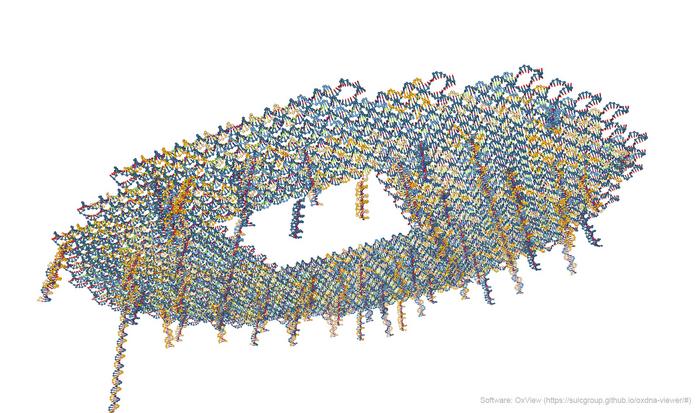
Using a groundbreaking technique known as DNA origami, scientists at the California Institute of Technology (Caltech) have unveiled an innovative method that promises to revolutionize the detection of proteins in bodily fluids, leading to the development of cheaper and more efficient biomarker sensors. This remarkable advancement could potentially eliminate the need for sending samples to laboratories, thus greatly expediting diagnostic testing. The work, spearheaded by a team that includes renowned researcher Paul Rothemund, signifies a major leap toward integrating nanotechnology into practical, real-world medical applications.
The concept of DNA origami, which was pioneered by Rothemund in 2006, leverages the natural properties of DNA to create intricate and specific shapes at the nanoscale. This approach allows researchers to manipulate long strands of DNA into predetermined structures, which can be outfitted with various functional components for applications in biosensing. Using powerful self-assembly processes, DNA molecules can be folded in intricate configurations, opening up possibilities for creating molecular devices that are both versatile and effective.
In their recent study published in the revered journal Proceedings of the National Academy of Sciences, the Caltech research team has developed a structure resembling a lilypad, anchored to a gold electrode by a DNA linker. This novel design incorporates multiple functionalities, making it capable of determining the presence of specific molecules, whether they be nucleic acids or proteins. Each lilypad is engineered to contain up to 70 redox-active reporter molecules that signal the detection of target analytes through measurable changes in electric current.
The way this sensor operates is quite fascinating. When a target molecule binds to the DNA strands on the lilypad, it induces a physical movement that pulls the lilypad down toward the electrode. This movement causes the reporter molecules to come into contact with the electrode, facilitating the transfer of electrons, which generates an electrical signal. The strength of this signal directly correlates to the amount of target analyte present in the sample, enabling highly sensitive detection that can be quantitatively assessed.
The advantages of using a DNA origami structure over traditional biosensing techniques are manifold. For instance, the larger size of the lilypad not only allows for more reporter molecules to be attached, enhancing the detector’s sensitivity but also enables the accommodation of larger biomolecules. This means that the sensor can be adapted for various targets—such as proteins or antibodies—without the need for radical redesigns, thus streamlining the testing process.
In their research, the team demonstrated the system’s versatility by modifying the oligonucleotides attached to the lilypad for interaction with specific proteins. By integrating a DNA aptamer—a type of molecule known for its capability to selectively bind to proteins—into the design, the researchers effectively turned the sensor into a highly targeted tool for detecting various proteins, such as the platelet-derived growth factor BB (PDGF-BB). This ability to tailor the sensor for different analytes represents a significant jump forward in the field of proteomics, which examines the protein content in biological samples.
Moreover, one of the most compelling features of this new sensor technology is its capacity for reuse. The researchers found that after conducting a series of tests, the sensors maintained a considerable level of performance. While there is a detectable decline in efficacy after multiple uses, the ability to conduct at least four rounds of testing with new adapters for different targets showcases the potential for cost-effectiveness and sustainability in diagnostics.
Caltech’s Guareschi, one of the lead authors on the study, emphasized the practical implications of this technology, illustrating that the modular design permits the quick reconfiguration of sensors to detect new molecules simply by adding compatible molecular adapters. This fluidity in functionality opens avenues for multi-analyte detection, where multiple sensors could analyze different proteins in a sample, making simultaneous measurements easier and more efficient.
As the researchers look toward the future, they envision applications extending beyond simple detection to include proteomic studies aimed at determining the concentrations of proteins in complex biological samples. Such capabilities could usher in a new age of rapid diagnostic tests in clinical settings, allowing for more effective and timely healthcare solutions.
Furthermore, the team utilized advanced fabrication equipment at the Kavli Nanoscience Institute, provided by institutional support from a range of organizations, including the Army Research Office and the National Science Foundation. This underscores the collaborative nature of cutting-edge research and its dependence on institutional backing, which enables innovative scientific developments to flourish.
The implications of this work resonate throughout the scientific community, with potential impacts on various fields, from clinical diagnostics to environmental monitoring. As the understanding and manipulation of DNA at the nanoscale matures, the threshold for what is achievable in biomolecular engineering continues to expand.
In conclusion, the innovative use of DNA origami for creating reusable biosensors marks a pioneering step in the evolution of molecular diagnostics. With its potential to allow for rapid, on-site testing of proteins in bodily fluids, this technology could transform how we approach medical diagnostics, providing an essential tool for the swift identification of diseases and enabling more personalized healthcare solutions.
Subject of Research: Development of modular DNA origami-based biosensors for detecting proteins
Article Title: Modular DNA origami–based electrochemical detection of DNA and proteins
News Publication Date: 30-Dec-2024
Web References: Proceedings of the National Academy of Sciences
References: Rothemund et al. (2006). DNA origami: A practical approach to DNA architecture. Nature.
Image Credits: Model: Matteo Guareschi/Caltech; Software: OxView
Keywords
DNA origami, biosensors, molecular diagnostics, nanotechnology, protein detection, Caltech, modular sensors, electrochemical detection, proteomics, biomedical engineering.
Tags: biomarker sensor developmentCaltech research advancementsDNA origami technologygold electrode integrationinnovative medical applicationsmolecular devices designmultifunctional biosensorsnanotechnology in medicinePaul Rothemund contributionsprotein detection methodsrapid diagnostic testing solutionsself-assembly DNA structures





